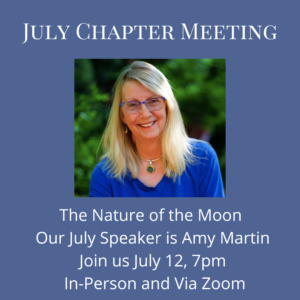
Tuesday, July 12 7PM CST
Charlise Hill Larson, 2019 and 2021-2022 Vice President
We usually think of nature as what surrounds us on Earth. But nature also includes the sky and the Moon beyond. The influence of the Moon on our lives is more than providing light for a moonlit hike and more than controlling the tides. The Moon made life possible on our planet due to synchrony and its extraordinary size. It formed our first calendars that many cultures still use. There is so much to learn about the Moon and its cycles. Our July Speaker, Amy Martin, will deepen our understanding.
After hearing Amy’s talk, you’ll be a pro-level Moon watcher, with a deep understanding of how Moon phases are created. You’ll be able to predict where the Moon will be at any time with some great timing tips on when the Moon rises and sets in each phase. You’ll understand the synchrony which creates tides and causes us to only see one side of the Moon, and you’ll discover how synchrony led to life on Earth and how the Moon stabilizes the planet to enable human life to evolve. We’ll explore how Full Moons at perigee create Super Moons and how perihelion makes the winter Moon much brighter. Get insight into this and much more as we welcome North Texas Master Naturalist, Amy Martin.
This will be a HYBRID meeting.
You can attend the July 12th chapter meeting in one of two ways:
- In-person at the Heard Museum Science Resource Center (SRC) or
- Online via Zoom
Physical Meeting Location: Heard Natural Science Museum & Wildlife Sanctuary, 1 Nature Place, McKinney TX 75069, Science Resource Center (SRC) building
Directions to SRC: Drive through Heard gates; go past parking lot and museum building; continue until the road ends at the large white SRC building.
Online Meeting Registration:
Register in advance for this meeting:
https://us02web.zoom.us/meeting/register/tZcsdOuvrT8iG9GONa3WYIOGW7DKzzAqDaDz
After registering, you will receive a confirmation email containing information about joining the meeting.
You will understand the following astronomy:
- How the phases of the Moon are created, all the way down to the 17 degrees it moves in a day and the 48 minutes later it rises each night.
- An easy synopsis of what time the Moon rises and sets in each phase, enabling pro level Moonwatching.
- Why the 2nd quarter is best for wildlife viewing, not the Full Moon.
- Why tides are highest at both New and Full Moons.
- Why solar eclipses are at New Moons and lunar eclipses at Full, and why they don’t happen every month.
- What creates a Supermoon (Full Moon at perigee, 30K miles closer).
- How the summer Moon arcs lower across the sky when the summer Sun arcs higher, and vice versa.
- Why the Moon is 13 percent brighter in winter due to perhelion (3 million miles closer to Sun).
- How synchrony makes only one side of the Moon visible and creates tides.
- How synchrony happened and why it led to complex lifeforms on Earth.
- How the immense size of the Moon in relation to its planet (roughly one-quarter the size of Earth, unlike any other planet in the solar system), makes it essentially a two-planet system and created the stability that enabled life here to evolve.


